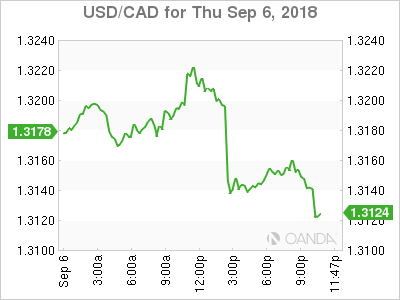The US dollar is lower against most major currencies on Thursday. Trade tensions continue to worry investors as NAFTA negotiations between Canada and the US drag on, although both sides remain optimistic. US-China relations are far form that place with $200 billion in US tariffs ready to go live on Friday. The ADP released earlier came lower than forecasted, private payrolls went up by 163,000 instead of 195,000. The U.S. non farm payrolls (NFP) will have a solid jobs number, but all eyes will be on wage growth. The market anticipates an interest rate hike by the U.S. Federal Reserve in September and a strong inflationary data point would validate that view.
- US expected to add 190,000 jobs
- US wages forecasted to gain 0.2 percent
- Canadian jobs to rise by 5,000
CAD Rises as Central Bank Willing to Hike if NAFTA Deal Crashes
The Canadian dollar rose on Thursday after Bank of Canada (BoC) Deputy Governor Carolyn Wilkins said that a breakdown in the US-Canada trade talks would not keep the central bank from raising interest rates.
The loonie had been under pressure for most of the day as comments out of Washington were not conclusive about the fate of the NAFTA 2.0. The Canadian central bank had kept interest rates unchanged on Wednesday giving little support for the currency. The comments from Deputy Governor Wilkins are a shot in the arm for the Canadian dollar ahead of employment data out of Canada and the United States on Friday.
The USD/CAD fell by 0.18 percent and is trading at 1.3153 with the BoC keeping its eye on inflation. Higher interest rates are need to achieve the CB’s target and Wilkins mentioned that sometimes trade protectionism could stoke inflationary pressures if consumer prices go higher.
Big issues remain on the table for the US and Canada and an instant negotiation was always a long shot. The deal struck by the US and Mexico took advantage of a Mexican presidential aftermath that eased negotiations to reach a bilateral deal.
Oil Drops after Trade Tensions trigger Demand Concerns
Oil prices fell on Thursday due to trade tensions escalating and putting downward pressure on global energy demand going forward. Crude fell despite a larger than expected drawdown of US weekly inventories of 4.3 million barrels as a rise in gasoline and distillates seem to point to appetite for crude ahead of the end of driving season.
The lagging crude stock data was less relevant to investors than the current trade disputes that have a negative impact on future demand for energy.
A quick agreement on NAFTA 2.0 remains elusive as Canada and the United States still have to work on big issues, which could delay the expansion of the bilateral agreement between the US and Mexico to include Canada.
The threat of a new round of tariffs on Chinese goods looms over the market. The Trump administration has toughened its stance on Chinese goods, with a $200 billion round of tariffs waiting in the wings. China is expected to retaliate escalating the trade war between the two economies and dragging down global growth forecasts.
Gold Rises on US dollar Softness
Gold rose above the $1,200 price level taking advantage of US dollar weakness. The yellow metal appreciated but faces a quick correction if US jobs data, inflation in particular comes in near or above target. The U.S. Federal Reserve has hiked two times in 2018 and is on course to lift rates twice more.
The CME FedWatch tool has the probability of the Fed funds rate reaching the 200 to 225 basis points at 99 percent. Trade tensions have had a mixed impact on the dollar with the Trump administration opening new fronts in the global trade war on a daily basis.
US fundamental data has been solid with the ISM non-manufacturing data adding to the case for further tightening from the Fed.
Market events to watch this week:
Friday, September 7
8:30am CAD Employment Change
8:30am CAD Unemployment Rate
8:30am USD Average Hourly Earnings m/m
8:30am USD Non-Farm Employment Change
8:30am USD Unemployment Rate













